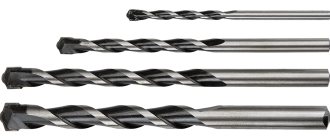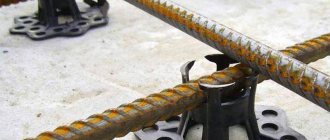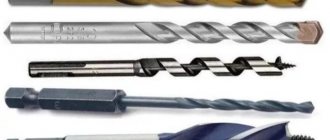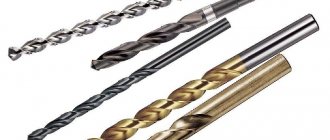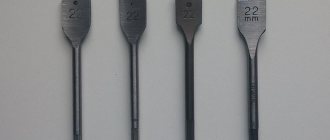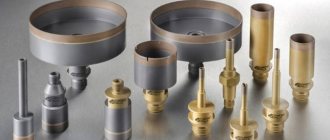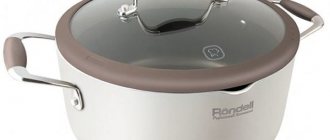Diamond is known to be one of the hardest minerals on earth. That is why the most effective tool for processing materials with high strength is a diamond drill. There are many types of diamond drills on the modern market, differing in both design and manufacturing technology.
For effective operation of diamond drills, it is necessary to take into account their technical parameters, the properties of the material being cut and the capabilities of the equipment used.
Types of Diamond Drills
Let's look at what tools exist in this category.
Among them are:
- conical;
- spherical;
- tubular;
- ring;
- spear-shaped.
The first type is similar to a traditional metal tool.
The drill looks like a countersink. Coated with diamond coating.
The second has a spherical cutting surface.
This type of diamond drills refers more to cutters
The third is made in the form of a tube, at one end of which there is a cylinder of diamond chips.
The fourth is a crown, the cutting surface of which is also covered with diamond crystals. This category contains products of the segmental type, in which the cutting surface is not continuous, but is made in the form of additional elements located at the working end of the product.
The fifth type got its name from the characteristic shape of the cutting part.
Main types
Diamond drills today are produced with various forms of working attachments. So, these could be tools:
- with a cylindrical working part (this includes tubular drills, as well as annular diamond drills);
- with a spherical cutting part;
- conical type;
- with a working part made in the form of a spear or feather.
Design features that affect the life of a diamond drill
The most traditional design has tools with a conical cutting part, which in appearance resemble a regular metal drill. Used primarily for drilling glass, ceramic and tiles, as well as stone products, they are available in a diameter range of 16–85 mm. The durability of a conical tool (that is, the depth of the hole, after drilling which it is subject to critical wear) is 9–12 meters when working on natural stone and 10–14 meters when making holes in other materials.
Diamond drills do not require constant cooling during processing, and also do not require regular sharpening. To prevent overheating (which is extremely undesirable), it is enough to periodically dip the tool in a container of water during drilling and carry out processing at low speeds.
Modes of operation with diamond drills
Advantages of diamond-coated drills
Drilling with diamond tools increases labor productivity and reduces material costs compared to the use of traditional drills. In addition, these tools have increased strength and durability, of course, subject to the technological process. They require less cooling.
The undoubted advantages also include low manufacturing cost and maintainability. In particular, the segments must be replaced, and on conical, ball-shaped and tubular drills with spraying, the working surface can be restored in industrial conditions.
Thus, in most cases, the final cost is reduced and the speed of work is increased while maintaining high quality.
Popular manufacturers
When drilling, diamond drills from various Russian and foreign manufacturers are used to perform operations in popular materials used in construction, mechanical engineering, agriculture and at home. Particularly popular are products from BOSCH, CEDIMA, AEG (Germany), Hilti (Liechtenstein), SPLITSTONE, ZUBR (Russia), DI-STAR LLC (Ukraine), etc. All of them provide a long service life, high quality of the resulting surface and productivity.
We ask those who have worked with such cutting tools to share their experience in the comments to the text, and also talk about the nuances of using a drill, screwdriver, electric screwdriver or machine for these purposes.
Technical features and production technology
A drill with a diamond coating is made either by sintering, when the crystals are joined together by the main alloy of the part during the production process, or by electroplating. Also, crystal segments are attached to a metal base through laser welding.
The first and third options are typical for parts of significant size, mainly for industrial use. The second is for small models of industrial and domestic use.
There is an opinion that this instrument needs to be cooled much less frequently than its usual metal counterpart due to the strong crystal lattice of the mineral. On the one hand, this is true, but on the other, a complete lack of cooling will lead to premature failure of the product.
To prevent this from happening, holes are drilled in the metal base, if the design allows, to facilitate the flow of air or liquid to the working surface.
If there are no holes, the tool is periodically immersed in water during operation. On an industrial scale, this problem is solved more simply: the machine already has a built-in system for supplying liquid to the area of contact between the drill and the workpiece.
Scope of drilling with diamond tools
As a rule, diamond drilling equipment is powered by electricity, but manual drilling rigs can now be found on the market.
Diamond drilling is used to create holes:
- in the foundation. Holes in the foundation are sometimes necessary to connect water and electricity supply systems, heating, and sewage systems to city highways;
- in the walls for laying pipes for water supply, heating, sewerage;
- in ceilings for water supply, heating, and sewage riser pipes;
- in ceilings and walls for installation of air conditioning systems;
- in ceilings and walls for ventilation valves and air ducts;
- for installation of chimneys, connection of heating devices;
- for supplying communications to swimming pools;
- for installing internal roof drain risers;
- for installing fencing railings on flights of stairs;
- for installation of automatic fire extinguishing systems.
Diamond drilling of holes in concrete, prices and efficiency largely depend on the equipment used. Diamond drilling can be carried out using rotary hammers or special installations . The latter are used for large volumes of construction work. Directly drilling holes is carried out with diamond drills or crowns.
Areas of application
The use of diamond drills is extremely wide: from drilling wells for pipelines to drilling parts of the most precise optical and radio-electronic devices. The most common application is in the field of construction and renovation work in premises. So, if it is necessary to make a hole in tiles or porcelain stoneware (for example, for an electrical outlet or switch), an annular diamond drill of the appropriate diameter is used.
When it is necessary to install electrical wiring in a room, it is allowed to work with an annular diamond drill with a diameter of 20 mm.
Also, a diamond annular drill is indispensable when processing natural, artificial stone and brick.
A special area of application is drilling glass surfaces. Here you can’t do without a tubular diamond drill. This operation requires high precision and experience from the worker due to the fact that the slightest mistake will lead to the formation of cracks around the hole and the surface will be hopelessly damaged. A conventional conical tool, unfortunately, causes these same cracks to appear, but a tubular drill does not.
When it comes to working with high-strength metal alloys, you need to use diamond metal drills.
Along with the external differences between products for performing certain jobs, they can also be distinguished by the color marking of the labels: for household tools - blue, for industrial tools - black is used.
Diamond drills for concrete - how to use correctly?
When carrying out renovations in premises, it is necessary to make holes for fastening objects in concrete or brick walls. Diamond concrete drills are used for this type of process.
Compared to metal drills, which quickly become dull, drilling with a diamond tool ensures a directed transfer of impact energy, maximizing the removal of slurry due to the spiral shape.
Characteristics of drills for concrete
A diamond-coated drill, or a diamond tubular drill, is a cylinder with 2 through passages on the sides to remove contaminants.
The main advantages of an electric drill include the equipment with strong alloys for soldering on top of the cutting element. The hardness of boron is as close as possible to the hardness characteristics of diamond. This alloy is called "win".
This type of drill is the most durable of all existing ones. Diamond bits are divided into 2 types:
- Designed for drills, available in polyhedron and cylinder shapes.
- Used for hammer drills with a cylindrical shank and marked SDS-plus, SDS-max.
There are products designed to work with a drill. More powerful products - crowns - are suitable for a hammer drill.
Features of use
When performing installation and using a drill, craftsmen obtain recesses ranging in size from 4 mm to 3 cm due to its versatility. Place the drill into the apparatus by pressing on the nozzle and pushing in the chuck, which is thickened at the end.
If the builder needs to achieve a recess in the wall up to 12 cm in diameter, they use another type of nozzle - a crown type. It is divided into subspecies: diamond and victorious.
The first one has a diamond coating, and the second one has small teeth made of pobedite.
If there is a need to drill passages for attaching sockets or switches, or a large number of wires, then use drills with a core drill. At the same time, it is imperative to know exactly the depth and diameter that you need to obtain in order to select the right tool. When choosing a suitable drill, they rely on the main feature - the larger the diameter needed, the longer the length.
Crowns are often used to create holes in a wall to accommodate an outlet.
How to use the device?
Electrochemical coating of one metal with another, which is more resistant to mechanical movement and chemical processes, allows you to select the appropriate drill diameter and type for different processes. You also need to make sure that the nozzle does not overheat. The cooling device should be stopped at regular intervals.
It is unacceptable to water the working parts with cold water. If, during drilling, an obstacle is discovered in the thickness of the concrete layer, you should change the drill used to cut metal. Having passed this section, insert the previous one again. For load-bearing walls it is better to use a hammer drill.
The power of this device will guarantee the required quality of the desired holes.
Nuances when using
When working with this category of tools, the same rules apply as when using classic options:
- Larger hole diameter means lower number of revolutions. Thus, a hole with a diameter of 1 millimeter is drilled at a speed of 6000 rpm, and, accordingly, 50 or more millimeters - at 100 rpm.
- A certain pressure force. For concrete surfaces it is greater, for glass it is much less.
If these rules are not followed, the diamond-coated drill will quickly lose its useful qualities.
When purchasing a tool, you need to imagine what types of work and on what scale will be performed. And it’s not only about the cost, but also about the resource laid down by the manufacturer.
Simply put, the difference between household and industrial designs of the same category is twofold. For example, a drill for porcelain tiles can be used up to 70 times for domestic purposes, and up to 120 times for industrial purposes.
There is another important parameter - the maximum drilling depth in one pass, after which the product is unsuitable for further use. This characteristic for the material mentioned in this paragraph ranges from 10 to 14 meters, depending on the diameter of the tool. Converting one indicator to another will not be difficult, provided that you carry out constant work with the same material.
Tools for drilling large diameter holes
To create cylindrical holes of large diameter, a special type of drill is used - crowns . The body of the drill bit has the shape of a hollow pipe. At one end of the housing there is a special mechanism for attaching the crown to the motor shaft, and at the other, diamond-containing segments are soldered. A drill with a small screw thread acts as a core. Its length is 1-2 cm greater than the height of the body. The core is used to center the hole being made.
Drilling concrete with a crown, the price of which is considered one of the disadvantages of this method, is performed using a heavy hammer drill or a special installation. The diameter of the crown can reach 1000 mm , and upon request it can be increased even more. In this case, the drilling depth is limited by the height of the housing.
Diamond drilling price
The price of diamond drilling should also include depreciation of tools and equipment, as well as energy consumption
The price of drilling holes with diamond tools is influenced by the following factors:
- complexity of the work (drilling a wall in a hard-to-reach place or at an angle);
- type of building material for the supporting structure of the building;
- diameter, depth and number of holes made.
Diamond drilling of holes in concrete, price:
| Hole diameter, mm | Brick, foam concrete, aerated concrete | Reinforced concrete, monolith |
| 40 — 70 | 15 rub/cm | 22 rub/cm |
| 80 — 100 | 17 rub/cm | 24 rub/cm |
| 200 | 30 rub/cm | 37 RUR/cm |
| 300 | 45 rub/cm | 60 rub/cm |
Diamond drilling of holes in concrete is shown in the video:
